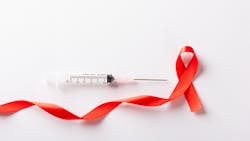How periodontal probing can help detect cancer
We’ve all run behind and seriously considered putting off periodontal charting for a patient until their next visit. And we all know the importance of charting periodontal pockets, bleeding points, mobility, and recession, but this can become time-consuming when we don’t have an assistant.
I heard about a dental visit where periodontal charting saved someone’s life because the diligent hygienist did not skip it and noticed a significant change in the patient’s bleeding on probing (BOP). The patient went to his doctor with this information and had blood tests, and he was diagnosed with myelodysplastic syndrome disorders (MDS), a group of cancers that affect blood cells.
I’ll confess that I don’t always enter BOP for my patients, and I have spot probed areas of previous periodontal pocketing rather than doing a full-mouth exam. But after hearing this patient’s story, combined with my own brother’s treatment for MDS, I now never put off periodontal charting and assessment of bleeding gums.
You might also be interested in: Retiring the “cleaning lady”: A futuristic approach to treating oral disease
What my brother went through
My brother learned he had MDS because he went into his doctor with fatigue, a small rash, bleeding gums, and a backache. After a complete blood count (CBC) with a differential count (diff), it showed that his red blood cells (RBCs), white blood cells (WBCs), and platelets were low. There were also myeloblasts (blasts) in the blood, which are an indicator of a bone marrow problem.1
His next test was a bone marrow biopsy, which looks at the size, shape, and other features of the cells. The doctors also looked for blasts, which are very early forms of blood cells. For a diagnosis of MDS, the patient must have less than 20% of blasts in the bone marrow and a patient with more than 20% is diagnosed with acute myeloid leukemia (AML).1
My brother’s diagnosis was myelodysplastic syndromes with multilineage dysplasia with excess blasts. He had the trifecta of the disease affecting his WBCs, RBCs, and platelets. During his yearlong treatment at the Seattle Cancer Care Alliance (SCCA), we met many others with this diagnosis. Their stories interested me, especially the connection of MDS to gingival hyperplasia and bleeding gums.2 Another patient discovered his MDS because a dental hygienist recognized an unusual amount of BOP. The hygienist encouraged the patient to seek medical care, and the MDS was discovered.
What is MDS?
What are myelodysplastic syndromes and their signs and symptoms? In a healthy person, bone marrow produces new, immature blood cells that mature over time. With MDS, the maturity process is disrupted, and these cells become defective. Eventually, there are more defective and immature cells than healthy ones, and this can result in symptoms that lead a person to seek diagnosis and treatment.3
Because of a decrease in the number of healthy blood cells, individuals experience different conditions. If there are too few healthy RBCs (anemia), there may be fatigue. If there are too few healthy WBCs (neutropenia), there may be frequent infections. With too few blood-clotting platelets (thrombocytopenia), there’s abnormal bleeding. When all three types of blood cell counts are low, this condition is called pancytopenia.3
MDS has subtypes that have been classified by the World Health Organization, and these subtypes are based on the type of blood cells being targeted. The subtypes are:4
- Myelodysplastic syndromes with single-lineage dysplasia: Only one type of blood cell (white, red, or platelets) is low in number and appears abnormal under the microscope.
- Myelodysplastic syndromes with multilineage dysplasia: Two or three blood cell types are abnormal.
- Myelodysplastic syndromes with ring sideroblasts: This involves a low number of one or more blood cell types. A characteristic feature is that existing red blood cells in the bone marrow contain rings of excess iron.
- Myelodysplastic syndromes with isolated del(5q) chromosomes abnormality: This is characterized by low numbers of RBCs and the cells have a specific mutation in their DNA.
- Myelodysplastic syndromes with excess blasts: Any of the three types of blood cells might be low and appear abnormal under the microscope. Blasts are found in the blood and bone marrow.
- Myelodysplastic syndromes, unclassifiable: There are reduced numbers of one or more types of mature blood cells, and the cells might look abnormal under the microscope. Sometimes the blood cells appear normal, but analysis may find that the cells have DNA changes associated with myelodysplastic syndromes.4
It is estimated that between 60,000 and 170,000 people live with MDS, and there are an estimated 87,000 new cases each year worldwide. Thirty-three to 35 new cases of MDS are diagnosed every day in the United States. MDS is more common in men than in women.
Smoking can be a determining factor in MDS. Exposure to benzene is also considered a possible factor, along with chemotherapy. While approximately 75% of MDS patients are 60 years of age or older, this syndrome can affect children and young adults. Unfortunately, one out of three MDS patients progress to acute myeloid leukemia (AML), so early detection and treatment are essential.4
My brother’s treatment
After a definitive diagnosis for my brother, the treatment recommended by SCCA was a bone marrow transplant. Interim treatments had been tried and resulted in no change to the defective blood cells. His only chance of survival was to find a donor for the stem cell transplant. SCCA and Be the Match National Marrow Donor program set out to find an anonymous donor. After a lengthy search, one was located, and the transplant schedule was set in motion.
My brother is one year post-transplant, and he’s experiencing symptoms of graft versus host disease (GVHD). The most uncomfortable and debilitating symptoms are painful aphthous ulcers, oral thrush, body rash, and difficulty swallowing. Chronic GVHD may present as lichen planus, and there’s a risk of developing oral squamous cell carcinoma, which has shown to differ from the classic pathology and is believed to be more aggressive in patients with stem cell transplantation.
The occurrence of GVHD in stem cell transplant from a human leukocyte antigen (HLA) matched donor, such as a sibling, is 50%, and much higher in unmatched donors. GVHD is considered one of the main causes of morbidity and mortality after stem cell transplant. GVHD is an ongoing concern for stem cell transplant patients, and their symptoms need to be monitored for the rest of their lives.5
While the cancer team will adjust the antirejection drugs, treating the oral manifestations from GVHD can be arduous and painful and should be regularly monitored by the dental team and the cancer team. Nystatin, prednisone, and dexamethasone are common medications prescribed to combat GVHD symptoms. Palliative and anesthetic mouth rinses can be helpful to relieve the oral pain.5
The difference between life and death
We perform several procedures for our patients such as diagnostic radiographs, extraoral and intraoral exams, periodontal charting with bleeding index, caries risk assessment, oral prophylaxis, laser therapy, and more. But two procedures are essential because they detect life-threatening disease. The oral cancer exam and the periodontal exam are where early detection and treatment can be the difference between life and death. Bleeding gums are associated with gingivitis and poor oral hygiene, and while these are still the primary reasons gums bleed, recognize that bleeding gums may be a sign of a more serious underlying health condition.
Having a document to review from previous visits showing the exact areas of BOP is ideal for noticing changes in a patient. We may be seeing a patient for the first time and need to refer to previous visit notes. While we’ve always equated periodontal disease with BOP, we need to look at it as a possible precursor to a more serious condition and conversation. Thorough and frequent periodontal exams that include bleeding points will give the hygienist a clear picture of the patient’s periodontal status, as well as whether there’s a need to seek more diagnostic tests to rule out serious diseases such as MDS.6
Editor's note: This article appeared in the August 2023 print edition of RDH magazine. Dental hygienists in North America are eligible for a complimentary print subscription. Sign up here.
References
- Tests for myelodysplastic syndromes. American Cancer Society. January 2018. https://www.cancer.org/cancer/myelodysplastic-syndrome/detection-diagnosis-staging/how-diagnosed.html
- Abed H, Alhabshi M, Alkhayal Z, et al. Oral and dental management of people with myelodysplastic syndromes and acute myeloid leukemia: A systematic search and evidence-based clinical guidance. Spec Care Dent. 2019;39(4):406-420. doi:10.1111/scd.12384
- Risk factors for myelodysplastic syndromes. American Cancer Society. January 2018. https//www.cancer.org/cancer/myelodysplastic-syndrome/causes-risks/prevention/risk-factors.html
- Czader M, Orazi A. World Health Organization classification of myelodysplastic syndromes. Curr Pharm Des. 2012;18(22):3149-62. doi:2174/1381612811209023149
- Justiz Vaillant AA, Mohammadi O, Modi P. Graft-versus-host disease. Stat Pearls Publishing. Updated October 10, 2022. https://www.ncbi.nlm.nih.gov/books/NBK538235/
- Epstein JB, Priddy RW, Sparling T, Wadsworth L. Oral manifestations in myelodysplastic syndrome. Review of literature and report of a case. Oral Surg, Oral Med, Oral Pathol. 1986;61(5):466-470. doi:10.1016/0030-4220(86)90389-0
About the Author

Theresa McCarter, BSDH, RDH
Theresa McCarter, BSDH, RDH, is a clinical dental hygienist licensed in California, Arizona, and Alaska. Theresa has been in the dental field for more than 22 years. She is a clinician, educator, author, and speaker. Theresa is the owner of Hygienewize, a CE-approved provider for the dental board of California, where she speaks on many topics related to dental hygiene and practice management. She is an active member of the National Speakers Association and the Dental Speakers Bureau.
